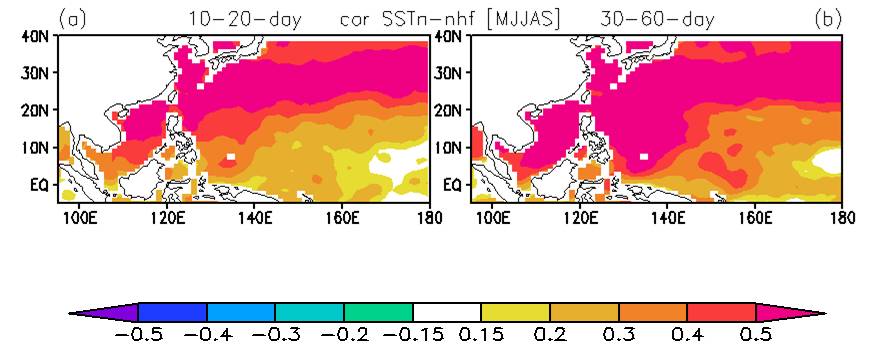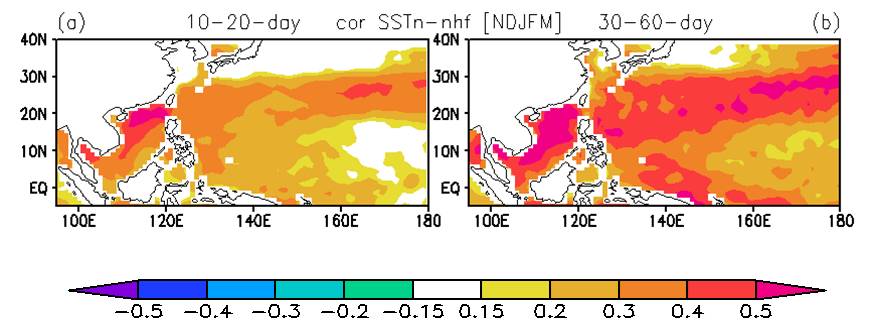
Intraseasonal variability is an important component of climate variability over the tropical Indo-western Pacific region. The sea surface temperature (SST) displays large intraseasonal variability in the above region. Understanding the intraseasonal SST variations and their coupling with atmospheric intraseasonal oscillations (ISOs) would advance the knowledge of the propagation and improve the prediction of ISOs.
Prof. WU Renguang and his collaborators from the Institute of Atmospheric Physics revealed that intraseasonal SST variations and their coherence with net surface heat flux (NHF) variations in the South China Sea and the western North Pacific display large differences between winter and summer and between the 10–20 day and 30–60 day time scales. The mixed-layer depth and the horizontal structure of atmospheric ISOs appear to be two important factors in determining the distribution of large coherent SST and surface heat flux variations.
A larger SST standard deviation is observed in the subtropics than in the tropics and during summer than during winter. The local NHF-SST tendency correlation is larger during summer than during winter. During summer, the distribution of local NHF-SST tendency correlation displays a clear difference between the 10–20 day and 30–60 day time scales. The high correlation is observed along a zonal elongated band over the South China Sea and the Philippine Sea on the 30–60 day time scale (Fig. 1b) and along a tilted southwest-northeast band from the South China Sea to the subtropics on the 10–20 day time scale (Fig. 1a).
"This difference is consistent with that in the structure of the ISOs between the 10–20 day and 30–60 day time scales." said Prof. WU, "During winter, however, there is no obvious difference in the distribution of the NHF-SST tendency correlation between the two ISOs (Fig. 2), which may be related to the fact that the two ISOs display a similar structure." Prof. WU concluded that these results indicate the importance of the structure of atmospheric ISOs in determining the distribution of intraseasonal SST variability.

Figure 1 Pointwise NHF-SST tendency correlation on the 10–20 day (a) and 30–60 day (b) time scales during May through September for the period 1998–2012. (Figure plotted by IAP)

Figure 2 The same as Figure 1 except during November through March. (Figure plotted by IAP)
The NHF contribution to the SST tendency appears to be more important on the 30–60 day time scale than on the 10–20 day time scale and during summer than during winter. A notable NHF contribution is detected in the South China Sea, the Philippine Sea, and subtropical western North Pacific. During winter, latent heat flux shows a larger variability and contribution to the SST tendency compared to net shortwave radiation on both the 10–20 day and 30–60 day time scales.
During summer, latent heat flux also shows a larger contribution to the SST tendency than shortwave radiation except in the South China Sea on the 30–60 day time scale. The larger contribution of surface heat flux to the SST tendency during summer than during winter is consistent with the seasonal change in the mixed-layer depth.

86-10-68597521 (day)
86-10-68597289 (night)

52 Sanlihe Rd., Xicheng District,
Beijing, China (100864)

